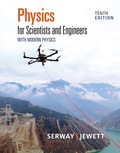
Physics for Scientists and Engineers with Modern Physics
10th Edition
ISBN: 9781337671729
Author: SERWAY
Publisher: Cengage
expand_more
expand_more
format_list_bulleted
Question
Chapter 38, Problem 33P
To determine
The momentum of the proton in
Expert Solution & Answer
Want to see the full answer?
Check out a sample textbook solution
Students have asked these similar questions
Concept Simulation 26.4 provides the option of exploring the ray diagram that applies to this
problem. The distance between an object and its image formed by a diverging lens is 5.90 cm.
The focal length of the lens is -2.60 cm. Find (a) the image distance and (b) the object distance.
Pls help ASAP
Pls help ASAP
Chapter 38 Solutions
Physics for Scientists and Engineers with Modern Physics
Ch. 38.1 - Which observer in Figure 38.1 sees the balls...Ch. 38.1 - Prob. 38.2QQCh. 38.4 - Suppose the observer O on the train in Figure 38.6...Ch. 38.4 - Prob. 38.4QQCh. 38.4 - Prob. 38.5QQCh. 38.4 - You are observing a spacecraft moving away from...Ch. 38.6 - You are driving on a freeway at a relativistic...Ch. 38.8 - Prob. 38.8QQCh. 38 - In a laboratory frame of reference, an observer...Ch. 38 - Prob. 2P
Ch. 38 - Prob. 3PCh. 38 - Prob. 4PCh. 38 - Prob. 5PCh. 38 - An astronaut is traveling in a space vehicle...Ch. 38 - Prob. 7PCh. 38 - You have been hired as an expert witness for an...Ch. 38 - Prob. 9PCh. 38 - Prob. 10PCh. 38 - Prob. 11PCh. 38 - A cube of steel has a volume of 1.00 cm3 and mass...Ch. 38 - Review. In 1963, astronaut Gordon Cooper orbited...Ch. 38 - You have an assistantship with a math professor in...Ch. 38 - Prob. 15PCh. 38 - Prob. 16PCh. 38 - A moving rod is observed to have a length of =...Ch. 38 - Prob. 18PCh. 38 - Prob. 19PCh. 38 - You have been hired as an expert witness in the...Ch. 38 - Figure P38.21 shows a jet of material (at the...Ch. 38 - Prob. 22PCh. 38 - Prob. 23PCh. 38 - Prob. 24PCh. 38 - Prob. 25PCh. 38 - Prob. 26PCh. 38 - Prob. 27PCh. 38 - (a) Find the kinetic energy of a 78.0-kg...Ch. 38 - Prob. 29PCh. 38 - Prob. 30PCh. 38 - Prob. 31PCh. 38 - Prob. 32PCh. 38 - Prob. 33PCh. 38 - Prob. 34PCh. 38 - Prob. 35PCh. 38 - Prob. 36PCh. 38 - Prob. 37PCh. 38 - Prob. 38PCh. 38 - Prob. 39PCh. 38 - An unstable particle with mass m = 3.34 1027 kg...Ch. 38 - Prob. 41PCh. 38 - Prob. 42APCh. 38 - Prob. 43APCh. 38 - Prob. 44APCh. 38 - Prob. 45APCh. 38 - Prob. 46APCh. 38 - Prob. 47APCh. 38 - Prob. 48APCh. 38 - Prob. 49APCh. 38 - Prob. 50APCh. 38 - Prob. 51APCh. 38 - Prob. 52APCh. 38 - The creation and study of new and very massive...Ch. 38 - Prob. 54CPCh. 38 - Prob. 55CP
Knowledge Booster
Learn more about
Need a deep-dive on the concept behind this application? Look no further. Learn more about this topic, physics and related others by exploring similar questions and additional content below.Similar questions
arrow_back_ios
SEE MORE QUESTIONS
arrow_forward_ios
Recommended textbooks for you
 Classical Dynamics of Particles and SystemsPhysicsISBN:9780534408961Author:Stephen T. Thornton, Jerry B. MarionPublisher:Cengage Learning
Classical Dynamics of Particles and SystemsPhysicsISBN:9780534408961Author:Stephen T. Thornton, Jerry B. MarionPublisher:Cengage Learning Physics for Scientists and Engineers: Foundations...PhysicsISBN:9781133939146Author:Katz, Debora M.Publisher:Cengage Learning
Physics for Scientists and Engineers: Foundations...PhysicsISBN:9781133939146Author:Katz, Debora M.Publisher:Cengage Learning Modern PhysicsPhysicsISBN:9781111794378Author:Raymond A. Serway, Clement J. Moses, Curt A. MoyerPublisher:Cengage Learning
Modern PhysicsPhysicsISBN:9781111794378Author:Raymond A. Serway, Clement J. Moses, Curt A. MoyerPublisher:Cengage Learning College PhysicsPhysicsISBN:9781305952300Author:Raymond A. Serway, Chris VuillePublisher:Cengage Learning
College PhysicsPhysicsISBN:9781305952300Author:Raymond A. Serway, Chris VuillePublisher:Cengage Learning College PhysicsPhysicsISBN:9781285737027Author:Raymond A. Serway, Chris VuillePublisher:Cengage Learning
College PhysicsPhysicsISBN:9781285737027Author:Raymond A. Serway, Chris VuillePublisher:Cengage Learning Principles of Physics: A Calculus-Based TextPhysicsISBN:9781133104261Author:Raymond A. Serway, John W. JewettPublisher:Cengage Learning
Principles of Physics: A Calculus-Based TextPhysicsISBN:9781133104261Author:Raymond A. Serway, John W. JewettPublisher:Cengage Learning

Classical Dynamics of Particles and Systems
Physics
ISBN:9780534408961
Author:Stephen T. Thornton, Jerry B. Marion
Publisher:Cengage Learning

Physics for Scientists and Engineers: Foundations...
Physics
ISBN:9781133939146
Author:Katz, Debora M.
Publisher:Cengage Learning

Modern Physics
Physics
ISBN:9781111794378
Author:Raymond A. Serway, Clement J. Moses, Curt A. Moyer
Publisher:Cengage Learning

College Physics
Physics
ISBN:9781305952300
Author:Raymond A. Serway, Chris Vuille
Publisher:Cengage Learning

College Physics
Physics
ISBN:9781285737027
Author:Raymond A. Serway, Chris Vuille
Publisher:Cengage Learning

Principles of Physics: A Calculus-Based Text
Physics
ISBN:9781133104261
Author:Raymond A. Serway, John W. Jewett
Publisher:Cengage Learning
Time Dilation - Einstein's Theory Of Relativity Explained!; Author: Science ABC;https://www.youtube.com/watch?v=yuD34tEpRFw;License: Standard YouTube License, CC-BY